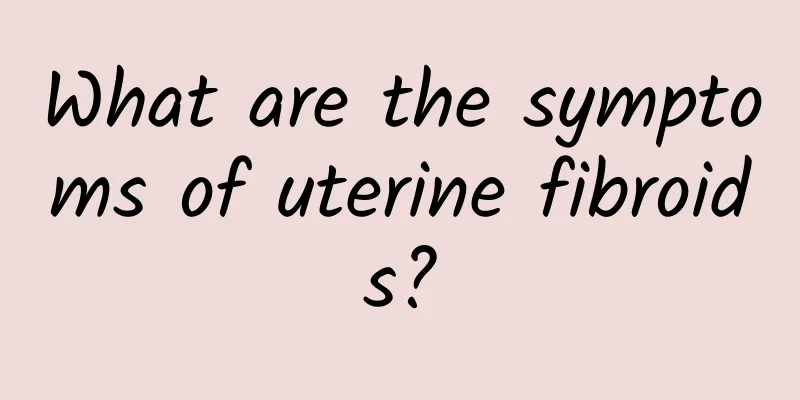What are the symptoms of uterine fibroids?

|
Speaking of uterine fibroids, I believe this is not unfamiliar to women. Uterine fibroids can be said to be an important reason that seriously threatens women's health in today's society. In the early stages of uterine fibroids, there are often no obvious symptoms, which makes it difficult for people to detect, which makes many women unable to prevent it. So what are the symptoms of uterine fibroids? Let me introduce you to this aspect: Symptom 1: Backache and abdominal pain: Common symptoms include lower abdominal distension, backache, etc. Acute pain may occur in some special cases, such as torsion of pedunculated fibroids, or red degeneration of fibroids during pregnancy, which may be accompanied by fever. Symptom 2: Abdominal mass: When the mass is large or grows too fast, you can often feel a mass in the middle of the lower abdomen. It is hard in texture and is easier to feel in the early morning when the bladder is full. Symptom three: increased leucorrhea: Intramural fibroids increase the area of the uterine cavity, increase the secretion of endometrial glands, and are accompanied by pelvic congestion, resulting in increased leucorrhea. If it is a submucosal fibroid, its surface is prone to infection and necrosis, producing a large amount of purulent and bloody secretions accompanied by a foul odor. Symptom 4: Abnormal urination and defecation: If the fibroids are large or grow in the cervix, broad ligament, etc., clinical symptoms of squeezing the adjacent pelvic organs may occur, such as constipation, frequent urination, increased residual urine, ureteral displacement, hydronephrosis, etc. Symptom 5. Menstrual changes: When fibroids enlarge the uterine cavity, increase the area of the endometrium, poor uterine contraction or excessive endometrial hyperplasia, or submucosal fibroids, they can all manifest as prolonged menstruation and menorrhagia. If not treated in time, it can lead to anemia. Symptom 6: Infertility: According to literature reports, many women suffer from infertility due to fibroids compressing or twisting the fallopian tubes, affecting the normal function of the fallopian tubes, or fibroids causing deformation of the uterine cavity, hindering the implantation of the fertilized egg. Symptom 7: Uterine bleeding: This is the most common symptom of uterine fibroids, occurring in more than half of the patients. Cyclic bleeding is the most common, which can manifest as increased menstrual volume, prolonged menstrual period, or shortened menstrual period. It can also manifest as irregular vaginal bleeding without menstrual period. Uterine bleeding is more common in submucosal fibroids and intramural fibroids, while subserosal fibroids rarely cause uterine bleeding. The above article is what I introduced to you today about the symptoms of uterine fibroids. Female friends must seek timely and active treatment after suffering from uterine fibroids to avoid making the condition worse. I hope my reply can be of some help to you. |
<<: The relationship between sexual intercourse and menstrual irregularities
>>: How to prevent menstrual irregularities caused by excessive hormones
Recommend
What are the symptoms of chronic cervicitis in women? Six major symptoms of chronic cervicitis in women
Chronic cervicitis is very common in clinical pra...
Don’t worry about not being able to regain your pre-pregnancy figure! 7 simple exercises to keep you slim and beautiful after losing weight
Combined with exercise, it can not only help you ...
Experts answer the symptoms of chronic adnexitis
Chronic adnexitis usually develops from acute inf...
Why does female cervical erosion lead to infertility? Analysis of the causes of female cervical erosion
1. Why does cervical erosion lead to infertility?...
Aerobic skipping helps lose weight. Keep skipping is the trick.
(Author: Park Gye-hwan, Bian Xuesheng, Diet Marke...
What is the cause of congenital absence of vaginal bleeding?
Congenital absence of vagina is a common gynecolo...
Can uterine fibroids cause miscarriage?
Can uterine fibroids cause miscarriage? Uterine f...
How to use medicine for recurrent vaginitis
Vaginitis, or inflammation of the vagina, is a gr...
Daily care for menopausal patients
When women reach the age of 50, they will experie...
Fitness is not difficult at all! The Korean fitness queen teaches you 3 home exercises to easily create a peach butt
Born fat, gained weight later in life, or having ...
How long does it take for bleeding from threatened abortion to stop before you can go back to work?
Threatened abortion is simply when a woman is les...
What causes ovarian cysts
Ovarian cysts are a disease with a high mortality...
My period has stopped for half a year. Why is it coming back?
My menstruation has stopped for half a year. What...
How much does a painless abortion surgery cost in Beijing?
Pregnancy is both a good thing and a bad thing fo...
How to treat irregular menstruation at the age of 14? 4 basic symptoms of irregular menstruation
Irregular menstruation is a common gynecological ...









